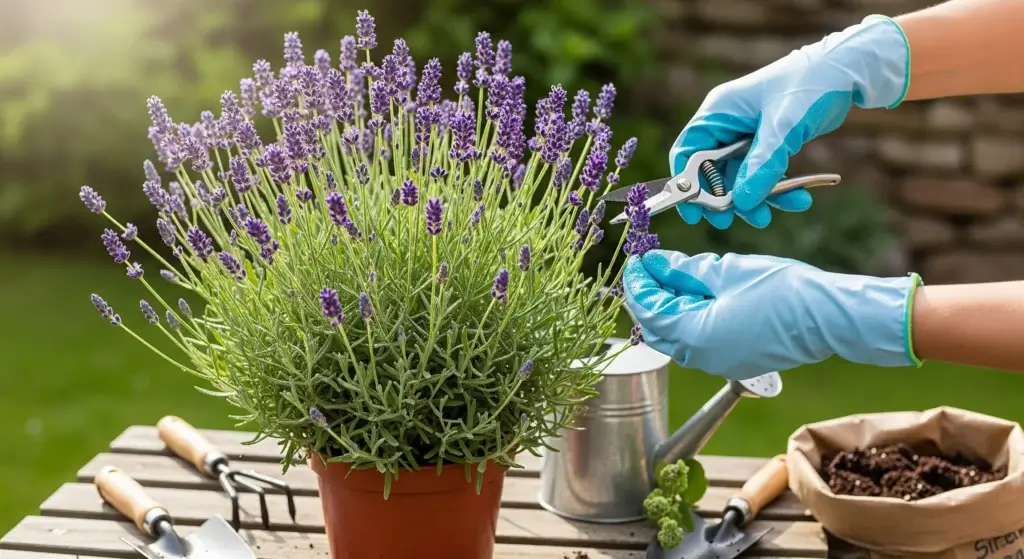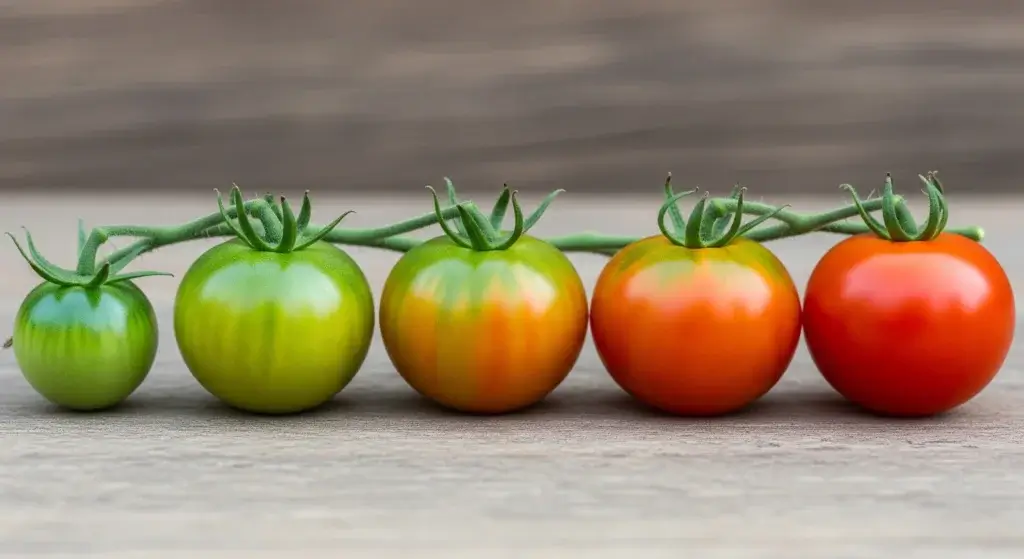Lavender is straight-up magical — silvery leaves, purple flower spikes, and a scent that actually smells like summer in a bottle. It looks chill, but it’s secretly picky: too much water or the wrong spot and it sulks (or dies). The good news? A few simple care moves — sun, sharp drainage, and smart pruning — turn it from drama queen into a forever-blooming legend.
Whether you’re just getting into plants or already flexing with a collection, this guide hands you the real tips: how to pick the right variety, where to plant it, how not to overlove it, plus quick fixes for common problems. Think of it as cheat codes for lavender — follow them and your garden will smell like Provence, not a sad science experiment.

Understanding Lavender: Know Your Plant
Lavender isn’t just a pretty face — it’s a tough little herb born under the blazing Mediterranean sun. It loves heat, hates soggy feet, and basically wants a summer vacation all year long. That backstory explains everything about how it grows.
There are tons of lavender types (over 45!), but here are the main celebs:
- English Lavender – the chill one that survives cold weather and smells amazing.
- French Lavender – fancy leaves, blooms all the time if it’s warm.
- Spanish Lavender – the drama queen with flower “bunny ears.”
- Lavandin – the overachiever hybrid that pumps out flowers for essential oils.
Each has its quirks, but they all crave sun, dry soil, and space to breathe — basically, they just want to live like it’s summer in the south of France.
Choosing the Perfect Location: Light and Positioning
Lavender is basically a tiny sun-addict — it needs 6–8 hours of direct sun (full-day sun is even better). Too little light and it turns leggy, flowers less, and gets cozy with diseases. Think bright, dry, and open — not a shady, damp corner.
Outdoor Placement
Pick the sunniest spot you’ve got — ideally south-facing with no buildings or trees throwing shade during prime daylight. Imagine the plant sunbathing all day; that’s the vibe you want. Don’t crowd it where shadows sneak in.
Air Circulation
Good airflow = fewer fungal problems. Plant lavender where wind can move through the leaves. Avoid tight nooks or walled-in spots that trap humidity and turn your lavender into a mold magnet.
Indoor Growing
If you’re keeping lavender inside, give it a south-facing window throne. Short on light? Add a grow light, especially in winter when daylight ghosts out. Keep it near fresh air and don’t treat it like a needy houseplant — less fuss, more sunshine.
Soil Requirements: The Foundation of Healthy Growth
Lavender is picky about its soil — like, diva-level picky. It hates wet feet and will straight-up die if its roots stay soggy. The secret? Fast drainage and airy soil. Think “Mediterranean beach vibes,” not “mud pit after rain.”
Ideal Soil Characteristics
Lavender loves light, sandy, or gravelly soil with a neutral-to-slightly-alkaline pH (around 6.5–7.5). If your dirt’s heavy like clay, you’ve gotta remix it — lavender doesn’t do mud baths.
Improving Soil Drainage
If your garden soil holds water, mix in sand, perlite, or small gravel down about a foot deep. Or skip the drama and plant on raised beds or mounds — basically, give those roots their own dry penthouse suite.
Container Growing
Planting in pots? Use a Mediterranean herb mix or make your own: two parts potting soil + one part sand or perlite. And make sure the pot drains fast — plug those holes and you’ll have a lavender funeral, not a plant.
Watering Wisdom: Less is Definitely More
If lavender could talk, it would scream, “Stop watering me!” Seriously — drowning it is the fastest way to kill it. This plant grew up tough in dry Mediterranean hills, so it’s built to handle thirst, not soggy roots. The trick? Chill with the watering can.
Establishing Young Plants
When lavender’s new, it needs a little extra care to settle in. Water deeply every few days for the first couple of weeks, but only when the top inch of soil feels dry. Think of it like training wheels — helpful at first, then off they go.
Mature Plant Care
Once established (around three months), lavender basically goes feral in the best way. It can live off rain alone. If it’s been dry forever, give it a deep drink every few weeks, not quick sips. That builds tough roots and makes your plant drought-proof.
Signs of Watering Problems
Yellow leaves or mushy roots? You’ve loved it too hard. Crispy, wilted leaves that don’t bounce back overnight? That’s thirst. But honestly, underwatering is rare — lavender’s biggest enemy is being smothered with kindness.
Fertilizing: A Minimalist Approach
Lavender is that chill friend who doesn’t need much to be happy — definitely not the plant version of a gym bro chugging protein shakes. Too much fertilizer actually backfires, making it grow a ton of leaves but barely any flowers, and it loses that legendary scent.
Out in the wild, lavender thrives in poor, rocky soil with zero fancy treatment. So if yours is in the ground, skip the fertilizer — seriously, it doesn’t need it.
But if you’re growing lavender in a pot or your soil’s basically dust, give it a small boost once in early spring. Use a slow-release, balanced fertilizer at half strength — think light sprinkle, not all-you-can-eat buffet. And whatever you do, avoid high-nitrogen stuff; it’ll make your plant go soft and floppy. If you want to keep things natural, a splash of compost tea or fish emulsion once in a while works great — just enough to say, “Hey buddy, here’s a snack, not a feast.”
Pruning: The Secret to Longevity and Abundant Blooms
Here’s the truth — if you don’t prune your lavender, it’ll turn into a scraggly, woody mess that looks more like a tumbleweed than a plant. Pruning keeps it cute, compact, and full of flowers. Think of it as a haircut that makes it glow-up every season.
Annual Pruning Schedule
Twice a year is the magic number. In early spring, before it starts growing wild, cut back about one-third — just above those fresh green shoots. It might feel harsh, but trust the process; it keeps the plant young and blooming like crazy. After its big summer show, do a light trim to clean up dead flowers and maybe score a second bloom.
Pruning Techniques
Always use sharp shears and cut just above a leaf node at an angle (so water slides off — no rot vibes). Whatever you do, don’t chop into the old woody base. That’s plant murder territory — it won’t grow back from there.
Rejuvenating Older Plants
With good care, lavender can live a decade or more. If yours is looking rough and woody, give it a “slow comeback.” Over two or three years, trim a little deeper each time to help it push out fresh growth. It’s like rehab — patience pays off.
Winter Protection: Preparing for Cold Weather
Lavender may be tough, but it’s not a snow warrior. English varieties can handle serious cold, but the fancier types? They need a little winter TLC to make it through. Think of it like tucking your plant in before the big chill.
Protecting Outdoor Lavender
Skip the fertilizer in fall — it makes soft new growth that frost nukes instantly. Once the first hard frost hits, toss some straw or evergreen branches around the base (not on top) to keep roots cozy. In icy regions, wrapping plants in burlap helps them survive winter’s worst mood swings. And drainage? Crucial. If water freezes around the roots, your lavender’s basically on ice skates — and not in a cute way.
Overwintering Container Plants
Potted lavender gets hit harder by the cold since its roots are more exposed. Move pots into a garage, shed, or bury them halfway in the ground with heavy mulch. If you’re growing the delicate types, bring them indoors somewhere bright but cool, and water just enough to keep them alive — they’re in nap mode, not thirsty mode.
Common Problems and Solutions
Even the best plant parents hit bumps — lavender included. Luckily, most problems are easy to fix if you catch them early. The key? Pay attention before things get ugly.
Fungal Diseases
Honestly, if you want to kill your lavender fast, drown it. Too much water is like kryptonite—root rot and leaf spot show up and party hard. The trick? Don’t baby it. Water only when the soil’s dry, make sure there’s a breeze, and definitely don’t let it sit there with soggy feet. Spot mushy roots or sad brown leaves? Hack off the nasty bits, fix the drainage, park it somewhere sunnier, and maybe just chill out on all the “pampering.”
Pests
Here’s the upside: lavender’s got that strong, grandma’s-perfume vibe, so most bugs are like, “Nope.” Still, every now and then you’ll spot a few freeloaders—spittlebugs, aphids, maybe a whitefly or two. Blast ‘em off with a solid spray from the hose (seriously, it works wonders). If they keep coming back, grab some organic insecticidal soap and show them the door.
Poor Flowering
No blooms? That’s lavender’s way of saying, “You’re doing too much.” Too little sun, too much fertilizer, or skipped pruning will all mess with its vibe. Move it to full sun, stop overfeeding, and give it a haircut — it’ll bounce back with flowers that make your whole garden smell like a spa.
Conclusion: Growing Lavender with Confidence
Lavender’s not needy—it just wants to party like it’s back on a Greek hillside or something. Sun? Give it all you’ve got. Dirt? Make sure it’s the kind that drains faster than a leaky bucket. Water? Barely any. Seriously, this plant’s allergic to overwatering. And trims? Yeah, don’t let it get shaggy, give it a haircut now and then. Do all that, and boom—you get flowers that look like a Pinterest board and a smell that basically screams “spa day.”
Whether it’s one plant in a pot or a full-on lavender field, once you get its rhythm, it’s basically unstoppable — a little purple powerhouse turning your space into a mini slice of Provence.



